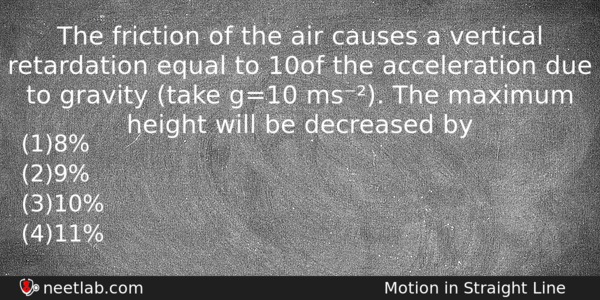| ⇦ | 
| ⇨ |
The friction of the air causes a vertical retardation equal to 10% of the acceleration due to gravity (take g=10 ms⁻²). The maximum height will be decreased by
Options
(a) 8%
(b) 9%
(c) 10%
(d) 11%
Correct Answer:
9%
Explanation:
Retardation due to friction of air = 8/10. Hence, in upward motion
Total retardation = g + (8/10) = 11g / 10
.·. H(m) = u² sin² θ / 2g
H(m)’ = u² sin² θ / 2×(11g/10) = (10/11)×(u² sin² θ / 2g) = (10/11) H(m)
.·. % decreases in H(m) = {[H(m) – H(m)’] / H(m)} × 100
= [1 – (10/11)] × 100 = 9%
Related Questions: - In the given figure, a diode D is connected to an external resistance R=100 Ω
- A parallel plate condenser with a dielectric of dielectric constant K between the plates
- If h is the height of the capillary rise and r be the radius of capillary tube,
- The phase difference between the flux linked with a coil rotating in a uniform
- In radioactive element, β-rays are emitted from
Topics: Motion in Straight Line
(93)
Subject: Physics
(2479)
Important MCQs Based on Medical Entrance Examinations To Improve Your NEET Score
- In the given figure, a diode D is connected to an external resistance R=100 Ω
- A parallel plate condenser with a dielectric of dielectric constant K between the plates
- If h is the height of the capillary rise and r be the radius of capillary tube,
- The phase difference between the flux linked with a coil rotating in a uniform
- In radioactive element, β-rays are emitted from
Topics: Motion in Straight Line (93)
Subject: Physics (2479)
Important MCQs Based on Medical Entrance Examinations To Improve Your NEET Score
18000+ students are using NEETLab to improve their score. What about you?
Solve Previous Year MCQs, Mock Tests, Topicwise Practice Tests, Identify Weak Topics, Formula Flash cards and much more is available in NEETLab Android App to improve your NEET score.
Share this page with your friends

Leave a Reply